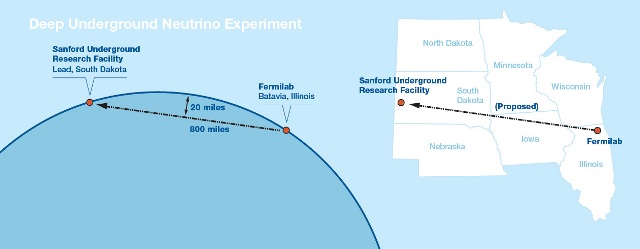Jun 9 2015
The U.S. Department of Energy (DOE) invites interested citizens to review and comment on the possible environmental effects of building and operating the Long-Baseline Neutrino Facility (LBNF) and the associated Deep Underground Neutrino Experiment (DUNE). The experiment will send a beam of neutrinos through the Earth from Fermi National Accelerator Laboratory near Batavia, Illinois, to the Sanford Underground Research Facility in Lead, South Dakota.
 This graphic illustrates the proposed LBNF/DUNE project, which will include construction at Fermilab in Illinois and at Sanford Lab in South Dakota. Image: Fermilab
This graphic illustrates the proposed LBNF/DUNE project, which will include construction at Fermilab in Illinois and at Sanford Lab in South Dakota. Image: Fermilab
DOE’s Draft Environmental Assessment (EA) analyzes the environmental and socioeconomic impacts of the proposed facility. DOE released the draft EA for public review and comment in accordance with the National Environmental Policy Act (NEPA). The comment period on the document is June 8 through July 10. To help people understand the document and start the comment process, DOE will conduct three public meetings:
- June 17 at 6:30 p.m. at Copper Mountain Resort, 900 Miners Ave., Lead, South Dakota
- June 18 at 6:30 p.m. at the Surbeck Center at the South Dakota School of Mines & Technology, 501 E St. Joseph St., Rapid City, South Dakota
- June 24 at 6:30 p.m. in the atrium of Wilson Hall, the main building at Fermilab in Batavia, Illinois
DOE, Sanford Lab and Fermilab will have people available at the meetings to explain the proposed project, the science it plans to accomplish and the specifics of the impacts that are listed in the EA. There are a number of ways people can comment on the document, including:
All comments, both oral and written, received during this period will be given equal consideration.
People interested in reviewing, downloading or requesting a copy of the document can view it on the LBNF website at http://lbnf.fnal.gov/files/LBNF-DUNE-Draft-EA.pdf. DOE expects to issue a final EA late this summer.
In Illinois, project leaders plan the construction of four buildings on the Fermilab site, one of which would be about 40 feet high, 160 feet long and located near Kirk Road and Giese Road. That building would be connected via a vertical shaft to an underground hall about 200 feet below the Fermilab site. The project also would include the construction of a 50- to 60-foot-high hill about 1,000 feet from Kirk Road on the Fermilab site as part of the facility that would create the neutrinos.
In South Dakota, project leaders plan the construction of one building at the surface adjacent to an existing building near the Ross Shaft. Approximately one mile underground, the project would include three large caverns, each about 60 feet wide and 500 feet long. These caverns would provide space for utilities and four large detectors filled with liquid argon to detect the neutrinos from Fermilab. Material excavated from the underground to create this space would be delivered to the surface and transported off site. A conveying system would be used on the surface as part of this transportation.
Particle detectors at Sanford Lab would record neutrinos from Fermilab and measure their properties. They also would look for neutrinos from a supernova and search for signs of nucleon decay. With the data, scientists aim to learn more about the building blocks of matter and determine the exact role that neutrinos play in the universe.
Neutrinos, which are also produced by our sun and in the interior of the Earth, are among the most abundant particles in the universe. Fermilab has been operating neutrino-producing facilities for more than 30 years. These include the construction in the early 2000s of a facility that now sends a beam of neutrinos from Fermilab straight through the Earth to Minnesota. The experiments that now use that facility have made important measurements of neutrino properties and how neutrinos interact with other building blocks of matter. The new project would greatly add to that research.
DOE is preparing this environmental assessment to identify and address potential environmental impacts from the proposed action and the range of reasonable alternatives. If significant impacts would result from the construction and operation of the LBNF/DUNE, a more detailed analysis called an Environmental Impact Statement would be undertaken. DOE has explored a number of potential impacts in the draft EA, including:
- Impacts from construction accidents and transportation;
- Impacts to both workers and the public from potential exposure to radiation and other hazards under routine operations and credible accident scenarios;
- Impacts on air, water and soil;
- Socioeconomic impacts; and
- Potential impacts on land-use plans, policies and controls, and visual resources.
Simultaneously, DOE will also be accepting comments on its Draft Programmatic Agreement to address the National Historic Preservation Act which requires DOE to consider the potentially adverse effects of its actions on properties eligible for listing and listed on the National Register of Historic Places. The Draft Programmatic Agreement, which pertains to proposed activities at Sanford Lab, appears in Appendix C2 of the Draft EA.
For additional details about the project, visit the website or contact:
Mike Weis, manager
Fermi Site Office
U.S. Department of Energy Fermi Site Office
P.O. Box 2000
Batavia, Illinois 60510
630-840-2227
[email protected]
For general information concerning DOE's NEPA process, contact:
Peter R. Siebach, NEPA compliance officer
U.S. Department of Energy (STS)
9800 S. Cass Avenue
Argonne, Illinois 60564
630-252-2007
[email protected]
DOE support of this project comes from its Office of Science's Office of High Energy Physics.